Reading view
Canals of Venice 1903-1910
In the early years of the twentieth century, the city of Venice grew in importance as a centre of art, with the Venice Biennale increasingly encouraging contemporary styles. That drew a succession of Post-Impressionists to depict the city and its famous canals.

Henri-Edmond Cross’s watercolour sketch of Venice – The Giudecca from 1903 is similar in approach to those painted by Paul Signac before he viewed Paul Cézanne’s late watercolours in 1908.

Cross’s Regatta in Venice from 1903-04 is a finished Pointillist painting in oils, bearing a strong similarity to those painted at this time by Paul Signac. In the middle distance there appears to be a race taking place.

Paul Signac’s fascination with Venice had been inspired by the writings of John Ruskin, in particular The Stones of Venice. In the course of the early years of the twentieth century, he turned his large collection of studies made in front of the motif into a succession of major Neo-Impressionist oil paintings. Among the first, which he completed in 1904, was this view of the Giudecca Anchorage showing the church of Santa Maria della Salute. This set the compositional approach for many of his views of ports, with colourful vessels in the foreground, and lofty buildings dissolving in the distance.

Another example from 1904 is Signac’s painting of The Lagoon. Yellow Sail with its rhythmic reflections.

Signac’s The Green Sail (1904) features the church of San Giorgio in the distance.

Meanwhile, John Singer Sargent found more unusual views of activities and parts of the city not normally seen by the visitor. This watercolour from 1904 shows Unloading Boats in Venice in the city’s port.

Basin of San Marco, Venice, completed by Signac in 1905, is one of the largest of his paintings of ports. This shows, at the left, San Giorgio Maggiore, in the centre Santa Maria della Salute, and to the right the Doges’ Palace and the Campanile of Piazza San Marco. In the foreground is a flotilla of bragozzi with their colourful sails. Signac’s preparations for this had been careful if not painstaking. They led from his watercolour sketches to a squared drawing with formal geometry and a planned colour scheme, which he then enlarged onto the canvas. He was clearly pleased with the result, and this work was featured in many of his subsequent major exhibitions.

My favourite among Signac’s views of Venice is his Entrance to the Grand Canal, Venice (1905). Its foreground is dominated by a shimmering and jumbled parade of gondolas, and melting into the distance is the towering silhouette of Santa Maria della Salute.

Sargent’s bravura watercolour sketch Grand Canal, Venice (1907) gives an idea as to his approach and style. It’s composed of a sparse collection of brushstrokes of watercolour which assemble into a detailed view. He sees Venice from the level of a gondola, the bows of which are also shown. His palette for these sketches is generally centred on earth colours for the buildings, with blue for the sky, water, and usually the shadows too.

In 1908, Ivan Trush visited northern Italy, where he painted this famous view of Venice, San Giorgio Maggiore. One of the smaller islands there, it has been painted extensively, perhaps most famously in Claude Monet’s late series. The church and its high campanile are prominent landmarks whose detail Trush has captured in this impressive oil sketch.

Signac painted Venice. Customs House in 1908, following a return visit to the city. This reverses his previous compositions by placing the Customs House in the mid-ground, with masts and sails behind. This loses the depth and grandeur of those earlier works.
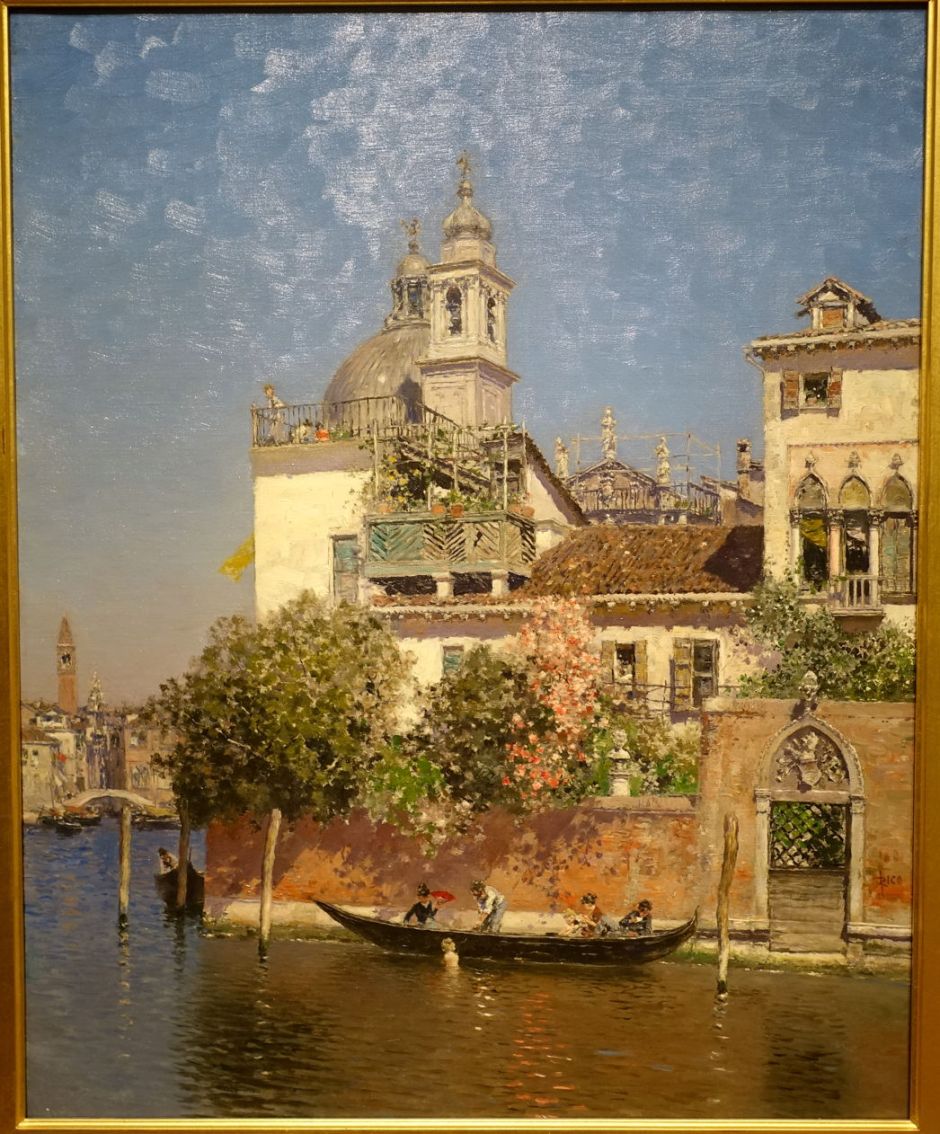
Martín Rico maintained his summer visits to Venice right up to the year of his death, when he painted this unusual view Near the Grand Canal, Venice (1908). A person is in the water beside the gondola, and the boatman is assisting them with a boathook while the other occupants seem quite detached from what is going on.

Sargent’s watercolours were by no means dependent on the sophistication of his technique: Rio dei Mendicanti, Venice from about 1909 works its magic almost entirely from a combination of wet on dry and wet on wet. There isn’t even much in the way of a graphite drawing under its thin washes.
Although the rise of Modernism brought fewer painters to the canals of Venice, they increasingly flocked to the Venice Biennale during the twentieth century, and Venice remains a focus of art.
Canals of Venice 1895-1903
By the end of the nineteenth century, the city of Venice had become established as an essential visit for every aspiring landscape artist. It not only attracted those painting traditional views (vedute) of its canals, but was drawing those in the avant-garde. This was encouraged by the start of the city’s biennial art exhibition, the Venice Biennale, the first of which opened on 30 April 1895.

The American Post-Impressionist Maurice Brazil Prendergast had a particular affection for the city, which he visited in 1898. The Canal, Venice from 1898-99 shows Riva di San Severo, and makes good comparison with Sargent’s looser watercolours of the canals, such as his Scuola di San Rocco from about 1903, shown later in this article.

Henri-Edmond Cross’s A Canal in Venice is also dated from 1899, and is an unusual Pointillist oil sketch of gondolas in one of the city’s smaller canals. Cross visited the city at this time, and again in 1903 and 1908.
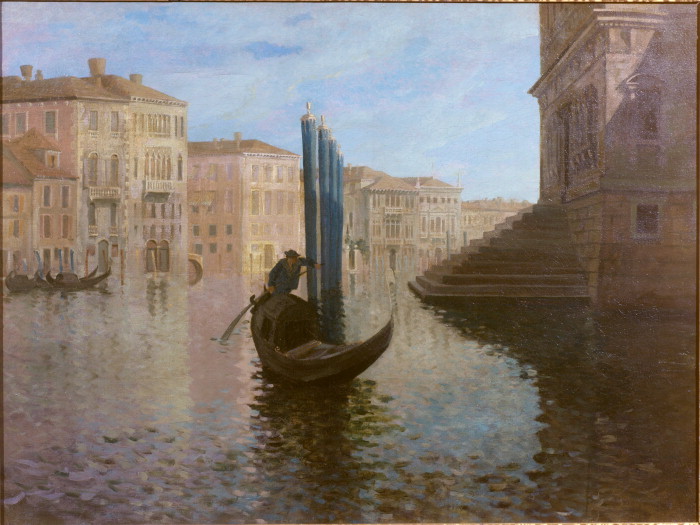
The young Roger Fry, who was to become an influential critic and promoter of Post-Impressionism, went to Venice in 1899 to learn to paint. His early works, including this view of Venice, appear realist with Impressionist tendencies.
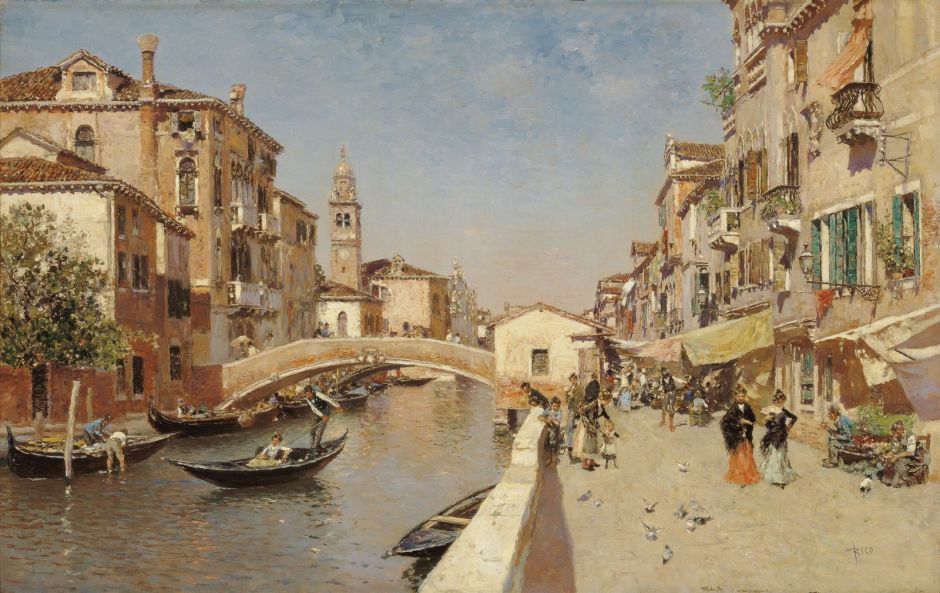
Martín Rico was still visiting Venice each summer. Some of his later paintings of the city are more populous and bustling, such as his San Lorenzo River with the Campanile of San Giorgio dei Greci, Venice from about 1900.
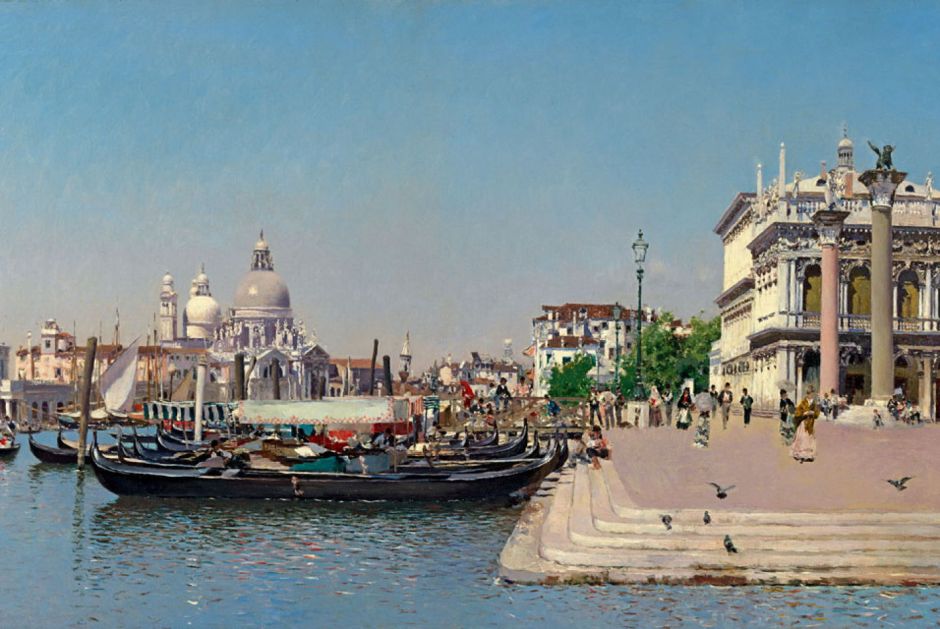
In about 1902, Rico painted this more direct view of the church of Santa Maria della Salute, Venice, with a small fleet of gondolas.

The British artist Walter Sickert visited Venice on several occasions between 1894 and 1904. His paintings make interesting comparison with those of John Singer Sargent, who was painting the city mostly in watercolour at the time. Sickert’s oil sketch of Venice, la Salute, thought to have been completed in about 1901, uses muted colours. He has cropped this unusually, showing only a portion of the famous domed church of Santa Maria della Salute. The artist also stressed how he had painted this in “full colour”.
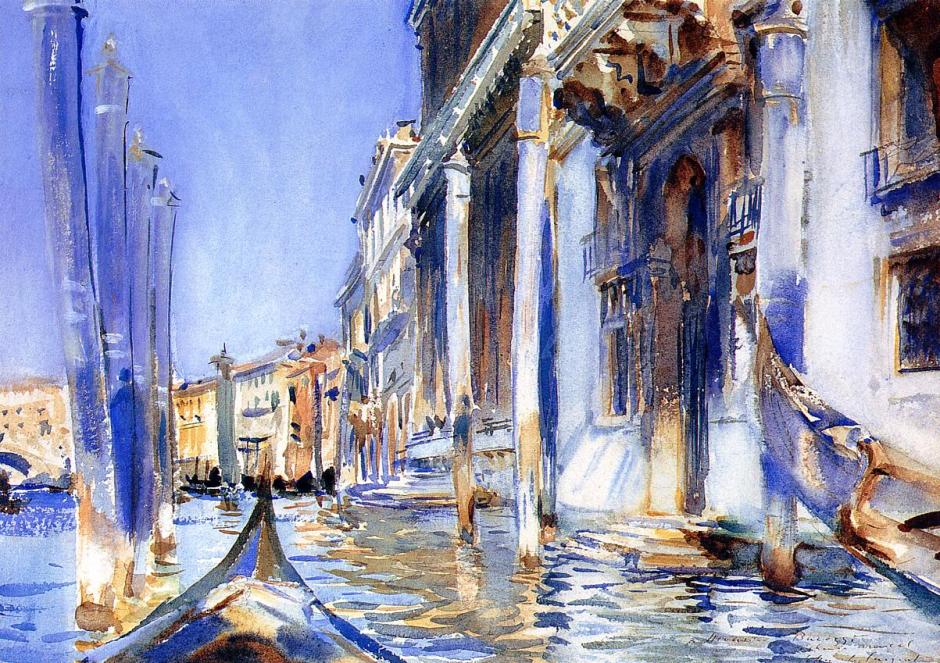
John Singer Sargent visited Venice repeatedly from about 1874, even before he became a student at the École des Beaux-Arts in Paris, and continued to do so after he moved his studio to London in 1886. His watercolour of Rio dell Angelo from 1902 is typically painterly and rich in chroma.

Sargent’s Scuola di San Rocco from about 1903 is one of his best-known watercolours, and another bravura painting.

In 1903, Mykhaylo Berkos visited the city, where he painted this watercolour view of boats On a Canal Near Venice (1903). Although few examples appear to have survived, he was an accomplished and prolific painter in watercolours as well as oils.

Frits Thaulow was an accomplished print-maker, and I think that this version of the Marble Steps (1903) in Venice is an aquatint. It shows the different approach he used to represent the broken water surface and its reflections.
In the early twentieth century, Venice was to become a focus of attention for the more avant-garde, notably Post-Impressionists with Pointillist techniques.
Canals of Venice: 1875-1895
In the closing decades of the nineteenth century, Venice became increasingly popular with painters. Access to the city had improved in the 1860s, when its Santa Lucia railway station opened at the north-west end of the Grand Canal, although the famous Simplon Orient Express train didn’t start operating into Venice until well into the twentieth century.
One of the earliest of this succession of artists was Martín Rico from Spain. It was his discovery of Venice in 1873 that led to the perfection of his artistic style and the creation of many of his most emblematic works. From this first trip until his death thirty-six years later, Rico spent every summer with the exception of one painting there, until he died in Venice in 1908.

Many of his paintings show lesser-known canals and less-frequented areas, like A Canal in Venice from about 1875. Although populated by the occasional gondola and a small clutch of children, they have a wonderful air of peace and serenity. His broken reflections are painted quite tightly although he is reputed to have painted mainly en plein air.

This undated view of the Grand Canal just catches the dome of the church of Santa María della Salute, Venice, and is also known by the fuller title of Grand Canal and the Church of Santa María della Salute, Venice.
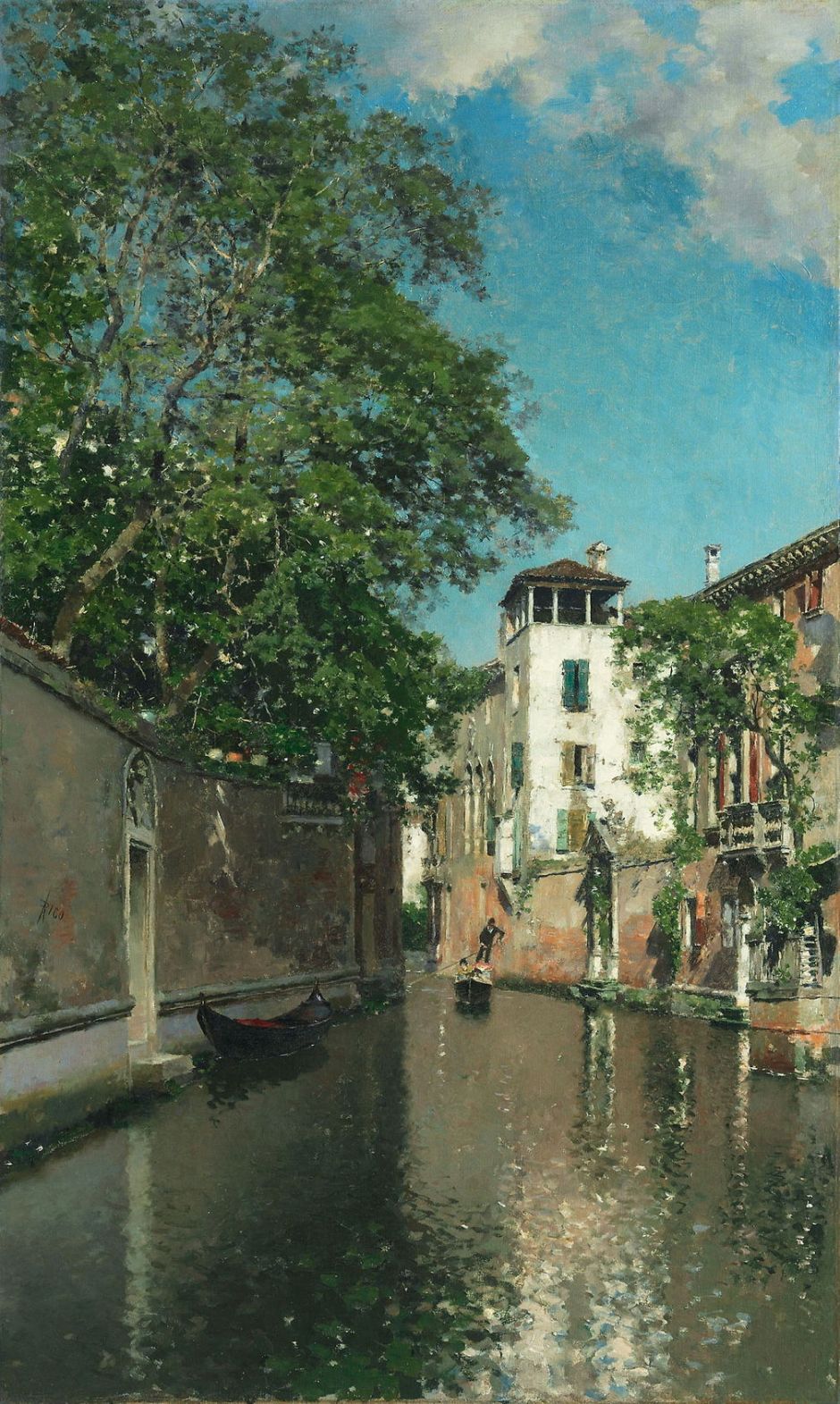
Rico’s Canal in Venice is another undated view of one of the minor ‘backstreet’ canals that is deeply serene.

His undated cross-canal view of Venice appears to be a ‘proper’ plein air oil sketch with rougher facture for once.

The first of several Impressionists to visit Venice, Pierre-Auguste Renoir chose a view of the famous Piazzetta adjoining Saint Mark’s Square in his Doge’s Palace, Venice from 1881. The tops of the roofs follow the horizontal centreline, with the Campanile reaching well above that, and various boats below the band of buildings.

The American Impressionist John Henry Twachtman was one of several great American landscape painters who visited Venice. His watercolour Venice (1881) was clearly painted quickly en plein air. The lower half of his paper contains only reflections; the upper half is a view from the water placing the Campanile slightly to the right of centre, little higher than neighbouring church domes. Superimposed on that waterfront are passing boats, their sails and rigging complicating the buildings behind. His palette is also limited to earth colours, with grey-blue on the water below.

The French Naturalist Pascal Dagnan-Bouveret also visited Venice, where his brushwork was surprisingly loose and his marks painterly, as shown in his sketched View of Venice (1882).

While he was working in Europe, the American Frank Duveneck visited the city on several occasions. His Grand Canal in Venice (c 1883) was a study for his Water Carriers below.

Duveneck was also a successful print-maker, as exemplified in his Bridge of Sighs (1883).

Water Carriers, Venice from 1884 is probably Duveneck’s finest painting of Venice, combining the view from his earlier study with an intimate insight into the daily work of ordinary Venetians. His visits to the city stopped when his wife died in 1888, and he returned to the USA.

In about 1885, Henri Rouart, one of the patrons of the French Impressionists and a talented painter in his own right, visited Italy. While there, he painted Venice, San Michele, showing the church of San Michele in Isola, on the island with the city’s main cemetery.
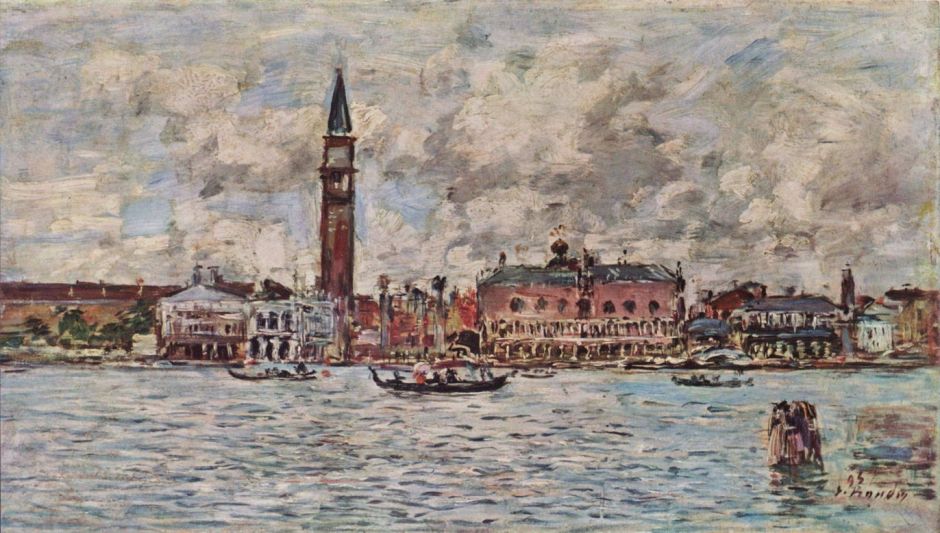
Towards the end of his career in the 1890s, Eugene Boudin visited Venice several times. Among his paintings there is Piazzetta San Marco in Venice (1895), which adopts the same view and composition as Renoir’s earlier Doge’s Palace, Venice from 1881. This painting is sometimes mis-titled as the Piazza San Marco, which it doesn’t show, although the tower is its high Campanile.

Franz Richard Unterberger was a landscape painter from the Austrian Tirol who produced many fine views of Venice in a more traditional Romantic manner. His Rio San Barnaba, Venice (date not known, but probably around 1895) gives a good account of his approach and style. The motif isn’t far from Saint Mark’s, but the tower shown isn’t the Campanile.
Although not as highly finished as the classical works of Canaletto, Unterberger puts great detail into buildings, figures, and other staffage, even down to painting the ties and walking sticks of figures. However, fine brushstrokes are distinct over the faces of buildings and in the water, and the clouds display marks more clearly.
In just a few years, at the turn of the century, Venice was to become popular with the most radical artists, including Divisionists such as Henri-Edmond Cross and Paul Signac, as well as John Singer Sargent.
Canals of Venice: 1825-1870
Few cities in Europe have been painted as much as Venice, with its distinctive canals and other waterways. First popularised by Giovanni Antonio Canal (1697–1768), better known as Canaletto, a native of the city whose vedute (views) sold so well to rich tourists undertaking their Grand Tours during the eighteenth century, they had faded by the start of the nineteenth.
In this series of four articles, I show how they were revived in the paintings of visiting artists, and played important roles in the development of twentieth century art. We start today with an English painter who was only twenty-three years old, and was to die within two years: Richard Parkes Bonington.

On the Grand Canal (1826) is a brilliant plein air oil sketch painted from a boat, showing the entrance to the Grand Canal, which snakes its way through the centre of the city. Bonington has removed one of the palazzi, but otherwise appears faithful to the motif.

Riva degli Schiavoni, from near S. Biagio (c 1827) shows the San Marco basin from the Arsenal traghetto, near the south-eastern entrance to the Grand Canal. Although only a small watercolour, Noon considers it was painted well after Bonington’s return from Italy.

Ducal Palace with a Religious Procession (1827) was apparently painted in late 1827 for James Carpenter, from graphite studies Bonington had made during his visit in 1826. Painted on a white ground, it unfortunately underwent severe shrinkage, and was extensively retouched as a result. However, it was generally very well received at the time, despite the liberties taken with its representation of the view.

Grand Canal, the Rialto in the Distance – Sunrise (1828) is one of Bonington’s finest oil paintings, made in the studio from graphite and other sketches from 1826. This painting has quite commonly been described as showing sunset, but as the view faces almost due east, must have been set in the early morning.

The Grand Canal Looking Toward the Rialto (1826), painted on millboard, may have been started en plein air, but appears to have been completed later in the studio, when Bonington had returned to Paris, which may account for the difference in hues in the sky. By the summer of 1828, Bonington was back in London, where he died of tuberculosis at the age of only twenty-five.

Between 1838-1848, the English traveller, writer and painter Edward Lear lived in Rome, making occasional visits to Britain. This quick plein air watercolour sketch of Venice, the Doge’s Palace is undated, but may well have been painted during this period.
JMW Turner paid many visits to Venice, where he painted some of his most radical landscapes.

Although Turner wasn’t particularly consistent in his reflections, at his most faithful he remains accurate in this famous view of Campo Santo, Venice from 1842, where reflected sails appear angelic in form.

Turner’s clouds and buildings in The Dogano, San Giorgio, Citella, from the Steps of the Europa, from the same year, have a similar softness in form typical of his later oil paintings.

John Ferguson Weir visited the city in 1868, following which he painted The Grand Canal, Venice (1869) in the studio, probably when he was back in the USA in the autumn of the following year.
Next Sunday, I’ll show paintings from the closing years of the nineteenth century, when Venice became even more popular.